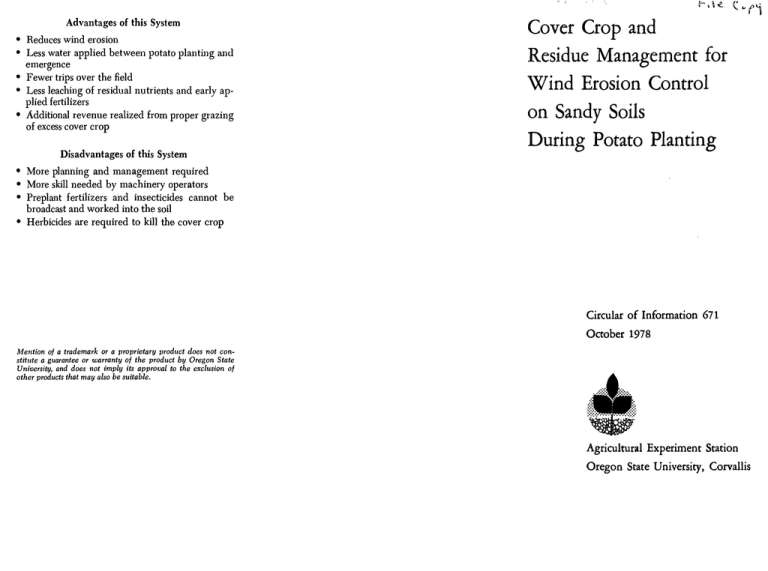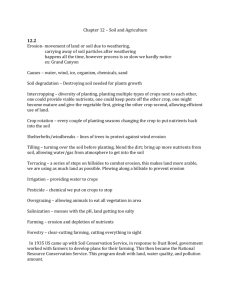Cover Crop and Residue Management for
advertisement

Advantages of this System Reduces wind erosion Less water applied between potato planting and emergence Fewer trips over the field Less leaching of residual nutrients and early applied fertilizers Additional revenue realized from proper grazing of excess cover crop Cover Crop and Residue Management for Wind Erosion Control on Sandy Soils During Potato Planting Disadvantages of this System More planning and management required More skill needed by machinery operators Preplant fertilizers and insecticides cannot be broadcast and worked into the soil Herbicides are required to kill the cover crop Circular of Information 671 October 1978 Mention of a trademark or a proprietary product does not constitute a guarantee or warranty of the product by Oregon State University, and does not imply its approval to the exclusion of other products that may also be suitable. Agricultural Experiment Station Oregon State University, Corvallis results from a combination of high wind velocities and bare soil. Usually the soil is sandy. These conditions occur at varying times in much of the center pivot agriculture developing along the Columbia River. Wind erosion is a serious problem and must be controlled if permanent and progressive agriculture is to exist. WIND EROSION Growers and researchers have developed a potato planting system which leaves cover crops and previous crop residues on the surface of the soil to control wind erosion. This system has been particularly beneficial under center pivot irrigation because it reduces wind erosion, eliminates applying irrigation water in an attempt to control erosion, and reduces the number of field operations. Greater efficiency of pieplant and starter fertilizer can be obtained. A critical wind erosion period in potato production occurs from initiation of seedbed preparation until the potato plants are large enough to protect the soil surface. Keeping cover crops and crop residue on the soil surface during this critical period requires intensive and careful management. The cover crop and residue which stabilize the soil during the winter should not interfere with potato growth, quality, and harvesting. With proper management, wind erosion is controlled, cost of production is reduced, and potatoes of good yield and quality are produced. The effectiveness of many wind erosion control practices is reduced or restricted by the characteristics of sandy soil and center pivot agriculture. The nearly structureless coarse textured soil cannot be formed into clods and rough surfaces that resist wind erosion. Center pivot irrigation systems are usually on large fields (120 acres or more) which have few if any wind barriers. High-value crops presently grown are annuals which leave lit- tie crop residue to cover and protect the soil after harvest. The following guidelines for avoiding a bare, wind-erodible soil surface over winter and during potato planting are suggested. Management Prior to Potato Planting A cover crop of a living cereal such as winter wheat has proved more effective in controlling erosion than spring cereals planted in the fall. Spring cereals planted in the fall are usually winter killed and are dead, brittle, partially decomposed, and frequently not anchored at potato planting time. Living winter wheat has proved to be more manageable and effective during and immediately after potato planting than cereal residues. A 100-bushel-per-acre wheat crop will produce approximately 10,000 pounds of straw (100 pounds of straw per bushel of wheat). This is more residue than is needed for wind erosion control and causes problems with row marking, potato planting, cultivation, and effectiveness of herbicides. To overcome these problems, straw and stubble should be incorporated into the soil soon after harvest by disking. Irrigation as needed will provide moisture for germination and establishment of a thick stand of volunteer grain. A cover crop should be seeded after the harvesting of crops which leave little residue such as beans, sugar beets, and potatoes. Late harvesting of these crops presents special wind erosion control problems because there is insufficient growing weather to establish a good cover crop. Seedbed preparation following such crops has proved not to be necessary for winter wheat establishment. The wheat can be seeded by airplane followed by rolling and irrigating if there is urgency for immediate seeding and plant establishment. Management of Cover Crop at Potato Planting AUTHORS: E V Pumphrey, professor of agronomy, D. C. Hanc, research assistant, and T. P. Davidson, assistant professor of horticulture, Columbia Basin Research Center, Hermiston, Oregon. The authors acknowledge with appreciation the initiation of this work by Dr. Charles Ullerv and the assistance of R. C. Cooper. Type, height, and density of the cover crop, weeds, straw, and stubble must be considered when deciding the best management practices to use prior to and during potato planting. Grazing, rotobeating, and herbicides applied prior to plant- ing can be used to prevent the cover crop from becoming too large and unmanageable. No seedbed tillage is needed prior to potato planting except marking of rows. Herbicides, cultivation, or a combination of the two are used to control and eliminate the cover crop and weeds. Herbicides for killing the cover crop should be applied pieplant or postplant, but before the potatoes emerge. Best results have been obtained when the herbicide was applied prior to row marking and where there has not been excessive straw and stubble. Dalapon at 5 pounds per acre with a wetting agent has been effective when applied to the cereal cover crop in the tillering stage of growth. Dalapon kills the plants slowly. This aids wind erosion control during planting and emergence of the potatoes. The cover crops should be sprayed with Dalapon from the late tillering to early jointing stage of growth even though the field may not be planted immediately. Application at this stage will assure a good kill of the cover crop and prevent the cover crop from becoming too large and competing unnecessarily with the potatoes for moisture and plant nutrients. Dalapon applied later than early jointing is much less effective in controlling the cover crop. Vegetation between the potato rows should be left as undisturbed as possible during potato planting. The cover crop and plant residues will decompose sufficiently during the summer and will not be a serious problem during potato harvest. Normal cultivation and hilling are done after the potatoes have emerged. Proper application of herbicides such as Eptam, Treflan, and Sencor, or a combination of herbicides, controls annual weeds and reduces the need for cultivation. Marking rows into the cover crop prior to potato planting allows the use of more than one planter in a field. One of several ways can be used to mark the rows: (1) a shank with a 6- to 14-inch wide duckfoot, (2) a rototiller cutting a strip up to 17 inches wide, or (3) a lister shovel. Subsoiling, if desired, and application of fertilizers, insecticides, and herbicides can be done as the rows are marked. Most operations can be done as the potatoes are planted, but too many operations during planting often reduce the acreage planted per day.




